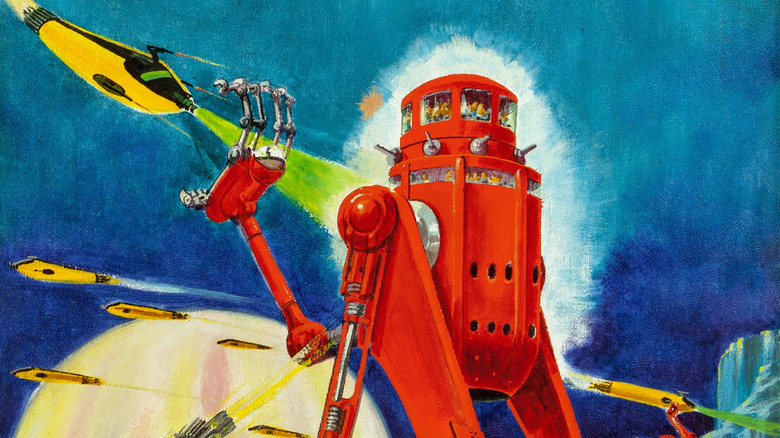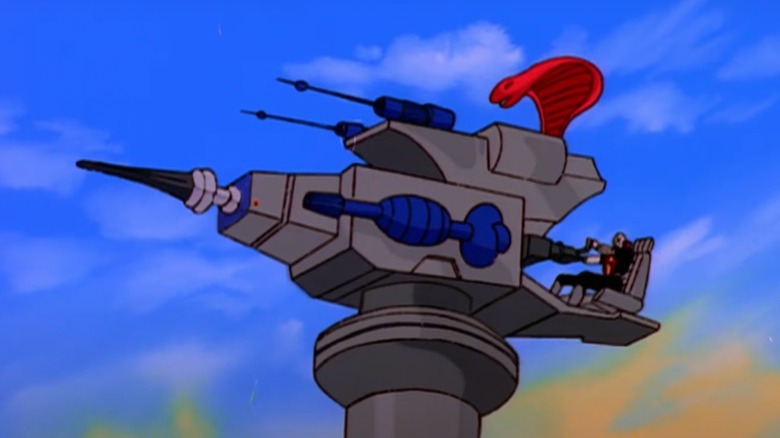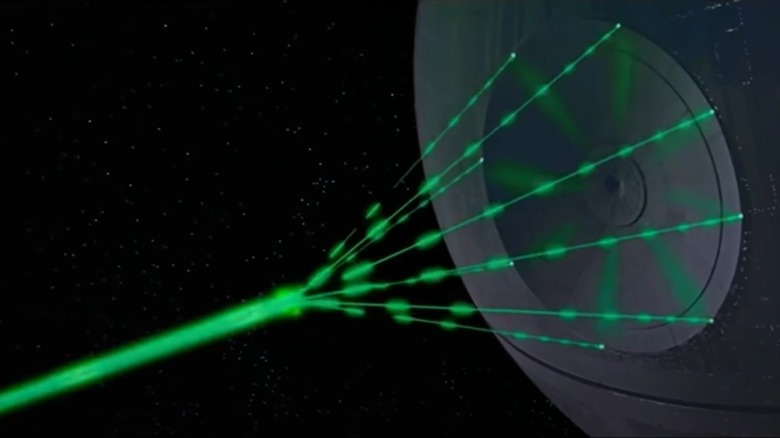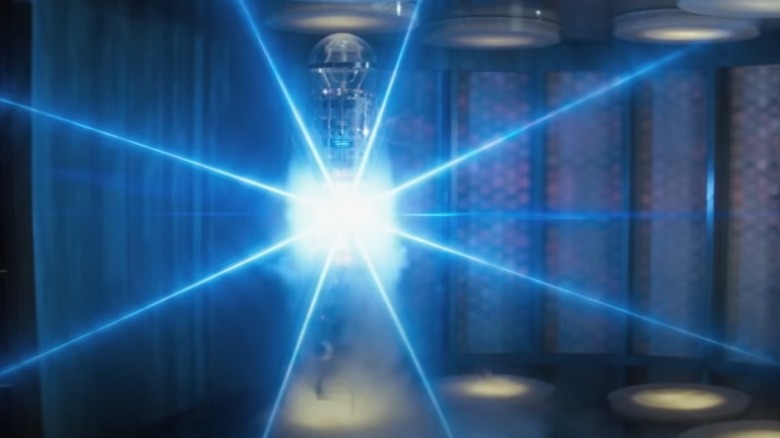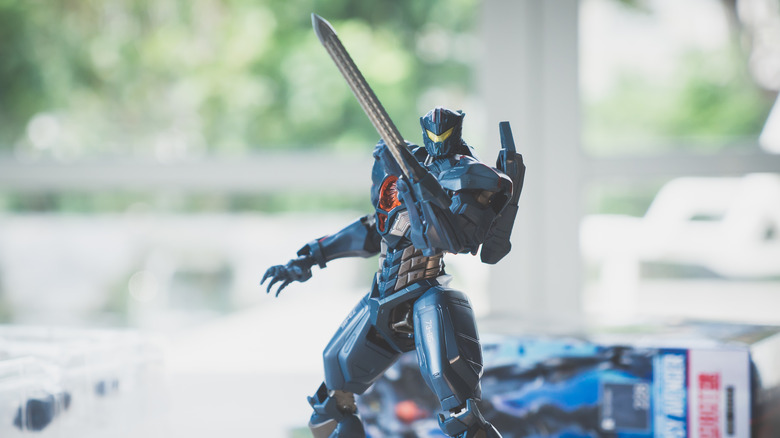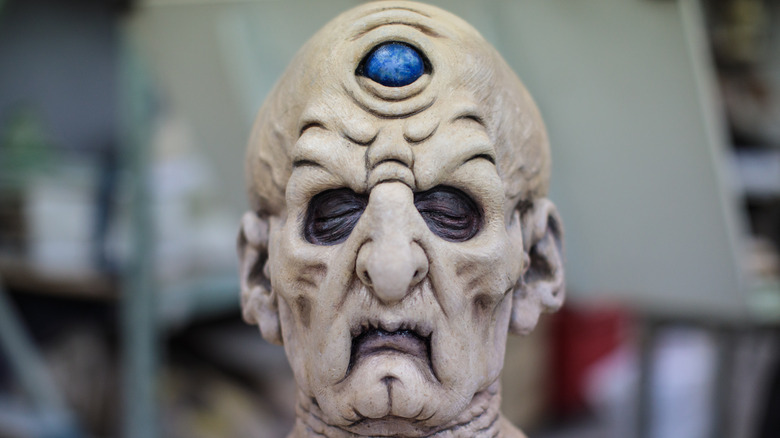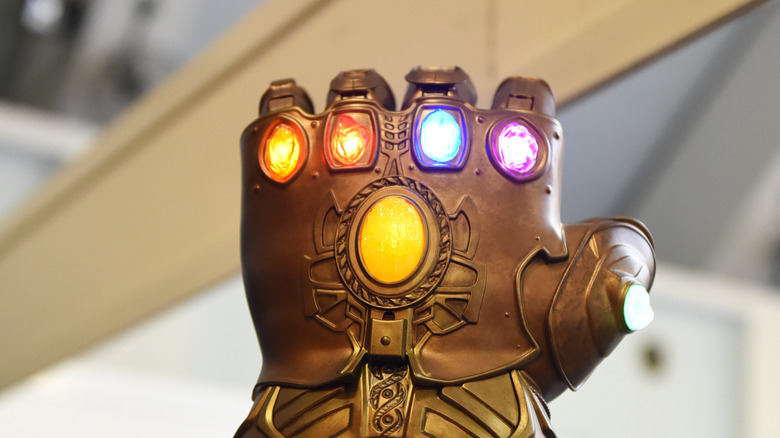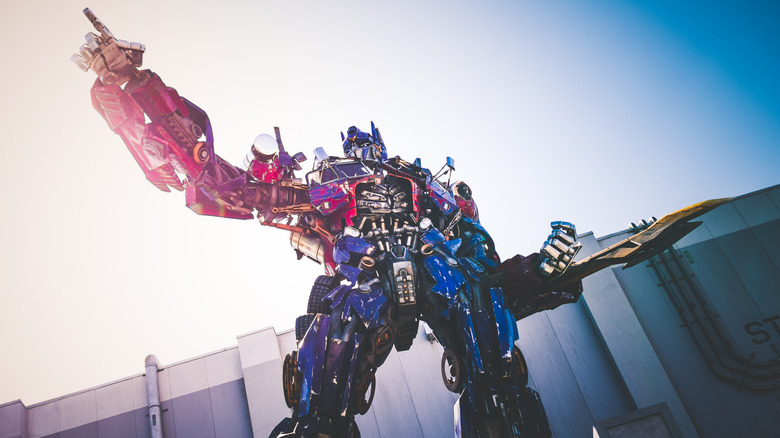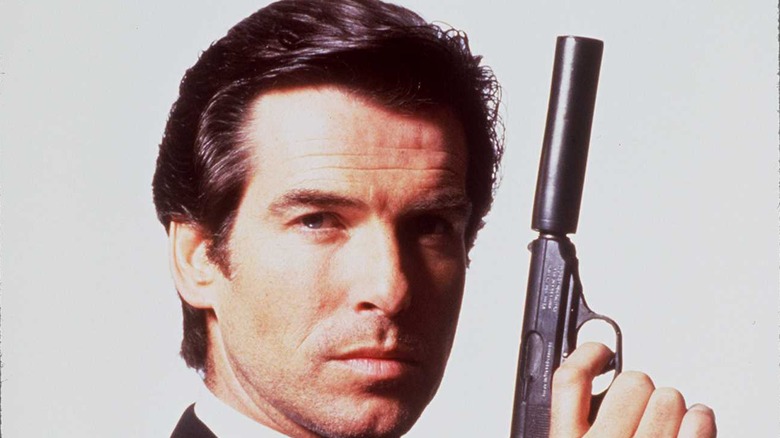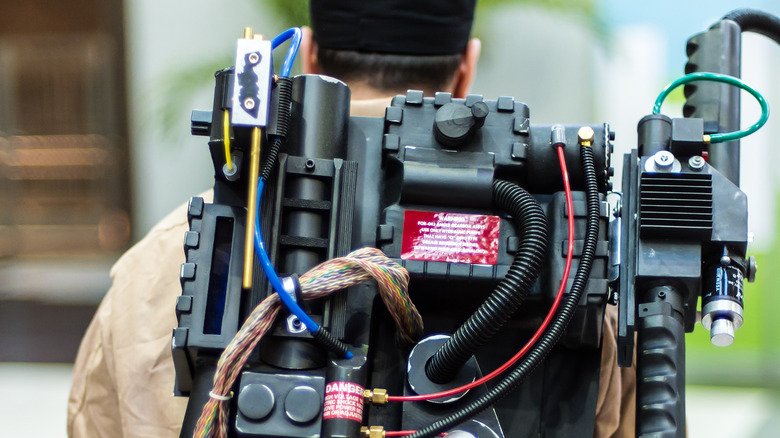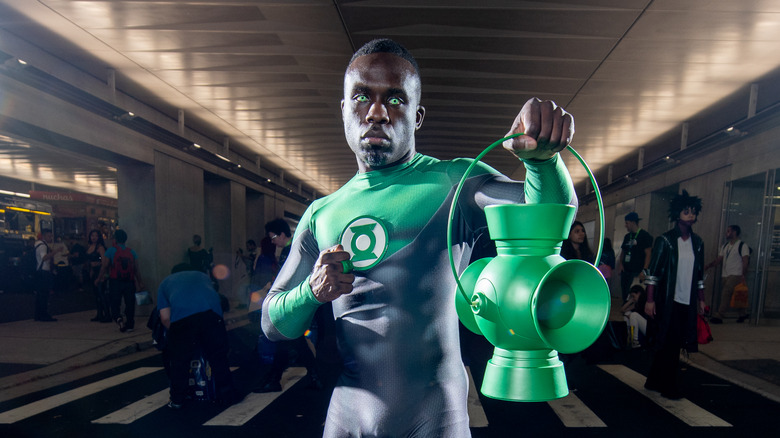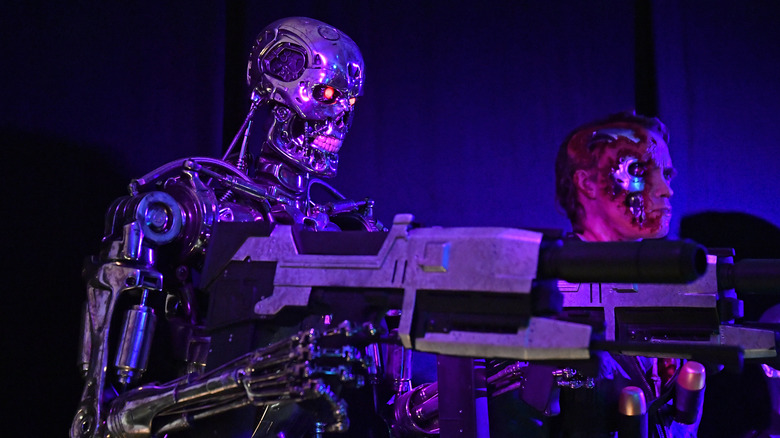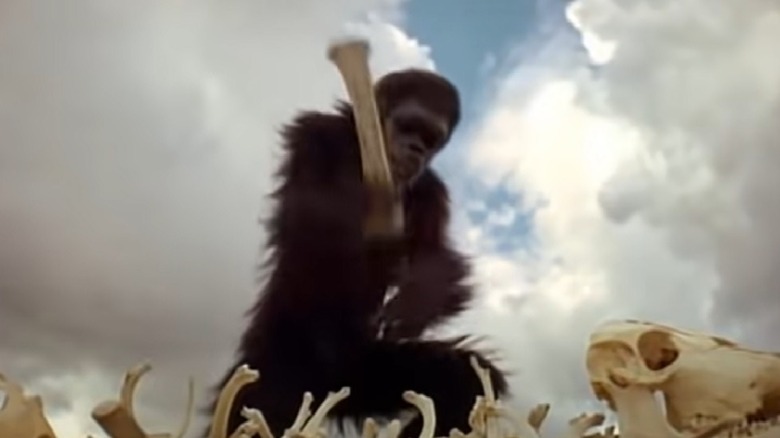The Most Powerful And Fantastical Fictional Weapons In History
If you are unlike most people, you hunger not just for global conquest, but universal domination. Think Lex Luthor, Emperor Palpatine, or Ganon. After all, why take over a planet when galactic clusters could be your new Disney World? But where to find the tools to do the task? Never fear, good reader. For those who need inspiration to fulfill their megalomaniac ambitions, there is a panoply of devices, tools, and even body parts littered throughout the annals of fiction that are so fantastical in their power as weapons that they cannot be anything but ... fictional.
What follows is an unranked selection of the most eminently powerful weapons that have graced the media. They are all equally fantastic in their own ways. This, however, does not make them less compelling for the preteen — and even postteen — set. These are plot MacGuffins which demonstrate the eternal struggle between good and evil. And they are equally subject to parody. So set your phasers to kill and load your ion cannons as we explore the most powerful and fantastical fictional weapons in history.
Weather Dominator
The 1980s were a fertile decade for military romanticism. Afterall, this last decade of the Cold War brought us such classics as "Top Gun" and "Commando." And who could forget the scrappy squad of high school students led by Patrick Swaze who fought a Soviet Invasion in 1984's "Red Dawn"? The same year kids may have flipped on the television to watch the cartoon "GI Joe: A Real American Hero." This cartoon was, according to Syfy Wire, produced by Hasbro and Marvel to support a line of toys and comic books. The series pitted a special forces team, GI Joe, against the terrorist organization Cobra which was bent on global domination.
The series featured multiple episode story arcs, and it was the second such arc, called "The Revenge of Cobra," which featured, as summarized by IMDb, Cobra's "Weather Dominator." What does this weapon do? Well, if you haven't guessed it, it controls the weather. Yet when the machine exploded, its component parts were flung across the earth, leading to a race between the Joes and Cobra. It is too bad that this particular device is fictional, since if it was legit, it might help against climate change. The whole story arc has made its rounds on Robot Chicken.
The Death Star
The line as spoken by Sir Alec Guinness' Obi Wan Kenobi in 1977's "Star Wars" — "That's no moon. It's a space station" – immortalized the Death Star as a trope of pop culture. It also built a mega-franchise. While the later Starkiller Base, as described by starwars.com, of "The Force Awakens" was more powerful, the original Death Star is far more memorable.
So what made it so powerful? The reasons are endless. About 100 miles in diameter, the Death Star used a hypermatter reactor (shrug), to power a superlaser that could destroy a planet. To defend this dastardly device of destruction, the evil Empire installed 10,000 Super Blaster 920 laser cannons and 50,000 quad laser cannons on its surface. These defended the in excess of 1 million imperial personnel that ran the whole thing. The Death Star even featured tractor beams to suck in wayward ships such as the Millenium Falcon and had a garbage compactor featuring a monster.
All these features did not stop Luke Skywalker from blowing the whole thing up with the help of the Force, though. So what to do? Seemingly out of original ideas, the Empire rebuilt the Death Star in time for "Return of Jedi," where it was promptly blown up again (although this time when it was half built). The Death Star has become the butt of numerous jokes, such as the memorable exchange in "Clerks" concerning contractors in the second Death Star.
Genesis Device
"The Wrath of Khan" is arguably the best movie of the "Star Trek" franchise. The movie features not only William Shatner's memorable "Khan" scream, but also the so-called "Genesis Device." Strictly speaking, the Genesis Device was not a weapon. According to "The Literary Galaxy of Star Trek," Genesis was a torpedo that created life. Its intent was to create worlds that could support life for habitation. However, there was a catch. In order to establish life, the device would destroy all life that was already existing on the planet then reassemble the atoms into a life-giving matrix. In one memorable scene, Dr. McCoy realizes the power of Genesis, saying, "According to myth, the earth was created in six days. Now, watch out! Here comes Genesis, we'll do it for you in six minutes!"
Over the course of the movie, Genesis gets into the hands of the eponymous villain and is used to nearly destroy the Enterprise. While Kirk and company get away, Spock, however, is killed. Genesis, as per startrek.com is detonated in a nearby nebula and created a life-filled, albeit unstable, planet. This sets up the stage for Spock's resurrection in "Star Trek III."
Jaegers
While 2013's "Pacific Rim" may not be the most impactful or best-rated science fiction offering to hit the theaters, it has, as noted by Rotten Tomatoes, a certain irresistible style. IMDb's synopsis hits the main points: Giant monsters called kaiju invade Earth from an extradimensional gate under the Pacific Ocean.
So what does humanity do when facing such an existential threat? Build giant robots!
In this case, the robots are called "Jaegers" and are piloted by two people — since one person alone can't seem to handle the job. These robots spawned a mini-franchise. They are honestly pretty cool. Wired reports that as conceived, Jaegers were up to 300 feet tall and outfitted with ridiculous armaments. They naturally violated most laws of physics. But really, who cares? As Scientific American tells it, one punch from a Jaeger is like getting clocked by a jumbo jet. If one weighs 7,080 tons, and if a punch is thrown at above human speed with the assistance of rockets, the mechanical arm would be carrying about 125 million joules of kinetic energy. It's science. And, oh yes, these mechs also can wield giant swords. Alas, these awesome robots probably can never be built; according to Gizmodo, they were too large and would need to be built on a smaller planet.
Reality Bomb
The BBC's "Dr. Who" has had a cult following for decades. "Whovians" are thrilled to follow the various incarnations of an alien adventurer, called the Doctor, on intergalactic and temporal adventures with great stories and traditionally bad set design. The history of "Dr. Who" started, according to Britannica, in 1963 with it being produced continuously until 1989. It then restarted in 2005, not as a reboot, but as a direct continuation of the series. The Doctor can be resurrected, which has allowed for a string of different actors to play to protagonist. When considering such a history, the Doctor has gathered a host of enemies, with one of his most prominent being the crippled alien megalomaniac Davros. According to "Doctor Who in Time and Space," it is Davros who is credited with creating the most powerful and fantastical weapon out there: the Reality Bomb.
What is a Reality Bomb? The physics are bit fuzzy, but the gist is that this weapon has the power to nullify the electrical field which holds the protons and electrons of atoms together. Thus, a reality bomb would destroy every atom in the entire universe (i.e. all of reality). How would Davros benefit? He and his Dalek minions would wait things out in a space ark, ready to rule a universe free of matter. Talk about simplifying things! Obviously the good Doctor didn't let this happen.
Infinity Gauntlet
The Marvel Universe's Infinity Gauntlet is a metal glove that is powered by six Infinity Gems (or stones) that control one aspect or other of the universe. These different facets seem to cover every conceivable thing: power, time, reality, soul, space, and mind. "American Comic Book Chronicles" details how these stones made their first appearance in the 1990s when the comic book writer Jim Starlin used them as a plot device for a series in which the intergalactic antagonist, the insane Thanos, used them in the "Infinity Gauntlet" mini series.
This plot line was so popular that it was adapted in the Marvel Cinematic Universe's crossover movie story. This reached a climax in, as detailed by IMDb, "Avengers: Infinity War" in which, with a snap of his fingers, Thanos eradicated half the life in the entire universe (Thanos was trying to fight overpopulation). Of course, comic books being comic books, the heroes manage to bring back the dead in the sequel, "Avengers: Endgame," and thwart Thanos' mad scheme.
Vogon Constructor Fleet
As it turns out, construction crews may be the most powerful weapon in the universe. In Douglas Adams' "Hitchhikers Guide to the Galaxy," the plot starts with the Earth being demolished to make way for a "hyperspatial express route" through the solar system. Of course humanity was unaware of such a plan despite there being notifications posted on nearby Alpha Centauri. When objections were made, the Vogons, who were the aliens in charge of destruction stated, "What do you mean you've never been to Alpha Centauri? For heaven's sake mankind, it's only four light years away, you know. I'm sorry, but if you can't be bothered to take an interest in local affairs that's your own lookout." With mutters about apathetic humans, the Vogons destroyed the Earth in about two minutes with various demolition beams.
So in Douglas Adams' universe, wielding a fantastical and powerful weapon like the Vogon Constructor Fleet does not require maniacal ambitions, just a building permit with the local interstellar planning and zoning commission.
Star Harvester
In terms of ridiculous and unlikely weapons, there is no better franchise than the Transformers. For those of you unfamiliar with the Transformers, they are, according to "Transformers: Identification and Price Guide," a line of toys developed in the 1980s which turned (i.e. transformed) from robots to different vehicles and other equipment. These toys also featured a highly popular cartoon which really launched the franchise into the pop culture stratosphere. As described by Vulture, there is an entire mythology surrounding this science fiction franchise in which one group of good Transformers (Autobots) battle the evil Transformers (Decepticons).
Of course, these Transformers have all sorts of powerful weapons. The most fantastical of these was the Sun Harvester, which was featured in "Transformers: Revenge of the Fallen." Star Harvesters are not weapons per se, but rather are a way to collect energy for the gas guzzling sentient robots. How do star harvesters do this? As the name suggests, they harvest stars, but not as green solar energy — they suck them in and destroy them. In particular, the movie featured a threat to the Earth's Sun being sucked up to be used to diesel up the Decepticon leader, Megatron. As always, it didn't quite work out for the Decepticons, but one has to appreciate the scale of Transformer energy needs.
Goldeneye
The James Bond franchise features some pretty ridiculous weapons from spiked shoes to killer bowler hats. However, perhaps the most powerful Bond weapon is featured in the 1995 movie "Goldeneye" where the weapon of the same name is featured. According to IMDb, Goldeneye was a satellite-based weapon which launched a nuclear warhead capable of delivering a powerful electromagnetic pulse (EMP). According to "Digital Soldiers," EMP weapons disabled or destroyed any electrical equipment. Thus, computers, the electrical grid, and almost everything that is needed to for the modern age would go kaput.
This weapon is not as fantastical as it may seem, since EMP effects have been known since the advent of nuclear weapons. In this case, it is the scale which is impressive, since in "Goldeneye," the city of London is threatened by a rogue double-0 agent. However, James Bond managed to save the day, win the romantic interest, and prepare to thwart the next madman who may try to launch a superweapon.
Lightsaber
The lightsaber, as conceived of in the "Star Wars" franchise, is probably one of the most powerful personal weapons in fiction. They are also the one weapon that is so desirable that even howstuffworks wrote an article on their speculative inner workings.
The heart of any lightsaber is a kyber crystal: a rare crystal that is especially attuned to the mystical Force, which grants Jedis and Sith their fantastical powers. The rest of the lightsaber is designed with scarcely pseudo-scientific parts to create an energy blade. This fierce energy sword can cut through hard armor, poke through blast doors, and ward off the most fantastical flurry of blaster shots. They also make really cool sounds. When "Star Wars" began, lightsabers were a single blade only, but later media in the franchise depicts double blades, multiple colored blades, and the like. So while the mind-warping physics of these blades stretches credulity, they are appreciably the object of fantasy for many children (and adults).
Proton Pack
1984's "Ghostbusters" was an almost flawless meeting of comedy and the supernatural. Bill Murray, Dan Ackeroyd, Harold Ramis, and Ernie Hudson played ghost exterminators in New York, which was experiencing an uptick in supernatural disturbances. To do the job, the Ghostbusters captured ghosts and stowed them in a containment chamber.
So how do you capture a ghost? You use a proton pack.
Syfy Wire takes time to explain the pseudo science behind these portable particle accelerators. You wore it like a backpack and shot a stream of nuclear-accelerated protons at a poltergeist, suspending it. You then could use the proton stream to guide the specter into a trap. The trouble was that if two Ghostbusters were firing their streams and crossed them, it would cause doomsday-like carnage. As Egon Spengler explained in the movie, "Try to imagine all life as you know it stopping instantaneously and every molecule in your body exploding at the speed of light." This "total protonic reversal" was an important thing to avoid and a "good safety tip," as commented on by Bill Murray's Peter Venkman. Of course, by the end of the movie, the Ghostbusters had to cross the streams to prevent the apocalypse.
Green Lantern's Ring
While not on the same level of popularity as Batman or Superman, one well-known character in DC Comic Books lore is Green Lantern. The most well-known of these is Hal Jordan, a test pilot who was bequeathed a green power ring from the dying alien Abin Sur. In doing so, Hal Jordan became a Green Lantern, a part of an interstellar quasi-police force that took their name from the green lanterns used to power up their rings.
So what does a Green Lantern's ring do? Well almost anything, but most commonly it is used to produce hard light constructs to fight bad guys. What the user can create is virtually limitless and depended on the willpower of the wielder. The ring's only weakness is that it is vulnerable to the color yellow. Why? Multiple reasons have been given over the years and being that these are comic books, those are likely to change (via Britannica). The bottom line is that theoretically, a Green Lantern ring could do almost anything (unless it involved manipulating a Twinkie). As Screenrant describes, the ring has been used not only to keep Jordan's mask glued to his face, but to turn himself into an envelope, and erase memories.
Terminators (various models)
The words, "I'll be back" were Arnold Schwarzeneggar's classic catchphrase in James Cameron's 1984 hit, "The Terminator." The plot, as outlined by IMDb, centered around a man who is sent back in time to prevent the assassination of Sarah Connor, a woman who will give birth to a son who will lead a successful rebellion against humanity's future robotic overlords. The trouble is, the assassin is Arnold Schwarzeneggar who happens to be the killerest robot assassin of all time.
The film spawned a franchise of numerous "Terminator" films and media. By the second film, Schwarzeneggar had become a good cyborg, and he now faced off against increasingly dangerous cyborgs sent from the future. Screenrant provides a thorough breakdown of the various strengths of these disparate terminators. It ranks Schwarzeneggar's T-800 and T-850 models somewhere in the middle. More powerful was the T-1000, which was made of liquid metal and could transform itself. Then there is the T-3000 which used a real human body transformed into a cyborg by nanobots. The most powerful of these terminator models is the hyperbolic T-1000000: a spider-like machine made of transformative metal. (This particular model only appears at Universal Studios theme park, though, so it isn't clear if it should count.) However, most enthusiasts would put their money on Schwarzeggar's version to pull through even against this big bad.
A bone
Stanley Kubrick's 1968 film, "2001: A Space Odyssey," was groundbreaking for its special effects but also the allegorical delivery of its story. The book, "Stanley Kubrick's 2001: A Space Odyssey" details the famous opening set, called "The Dawn of Man," in which ape-like hominids are struggling for survival and squabbling over territory with other bands of hominids. Then one day, a black monolith appears. This unexplained structure seems to impart in the hominids knowledge of using tools.
This is shown when the leader of the hominid band begins to smash things with bones: first other bones, then other animals, and then the leader of a rival band. These are the creatures that would evolve to be humans. Through the bone, they have now become masters of their own destiny, but it also was an allegory for the ability of humans to do violence to one another, something that would grow as technology developed.
